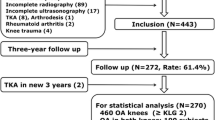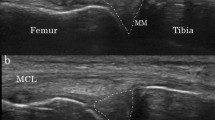Abstract
To examine the morphological changes of the medial meniscus in advanced knee osteoarthritis (OA) we examined 167 knee joints of 106 patients who subsequently underwent total knee joint arthroplasty from January to May, 2007. All 106 patients were females and their ages ranged from 57 to 83 years (mean 68.7 ± 5.6 years). For patients with complete loss of medial joint space by weight-bearing radiography, the meniscal position was assessed by measuring meniscal subluxation and meniscal height. Meniscal morphology was assessed using a modified WORMS MRI-based method. Description of the prevalence of different meniscal morphologies and their respective positions are presented. The predominant type (32.2, 64.1 and 83.8% in anterior horn, mid-body and posterior horn, respectively) of meniscal morphology abnormality was a hypertrophied displaced tear. Medial meniscus height was found to be higher than lateral meniscus height. In persons with an hypertrophied meniscus the height of the medial meniscus was 8.06 ± 1.15, 10.03 ± 1.79, and 8.61 ± 1.57 mm at anterior horn, mid-body and posterior horn, respectively, compared to those in other categories whose height was 6.04 ± 0.92, 5.08 ± 1.68 and 6.43 ± 1.26 mm. A large proportion of persons with end stage varus knee OA have a paradoxically hypertrophied medial meniscus. This new finding of hypertrophied menisci highlights that not all menisci in persons with end stage OA are macerated or destroyed.




Similar content being viewed by others
References
Chan WP, Lang P, Stevens MP, Sack K, Majumdar S, Stoller DW et al (1991) Osteoarthritis of the knee: comparison of radiography, CT, and MR imaging to assess extent and severity. AJR 1991. Am J Roentgenol 157:799–806
Brandt KD, Dieppe P, Radin EL (2008) Etiopathogenesis of osteoarthritis. [Review] [113 refs]. Rheum Dis Clin North Am 34:531–559
Kindynis P, Haller J, Kang HS, Resnick D, Sartoris DJ, Trudell D et al (1990) Osteophytosis of the knee: anatomic, radiologic, and pathologic investigation. Radiology 174:841–846
Seedhom BB, Dowson D, Wright V (1974) Proceedings: functions of the menisci. a preliminary study. Ann Rheum Dis 33:111
Verstraete KL, Verdonk R, Lootens T, Verstraete P, De Rooy J, Kunnen M (1997) Current status and imaging of allograft meniscal transplantation. [Review] [32 refs]. Eur J Radiol 26:16–22
Baratz ME, Fu FH, Mengato R (1986) Meniscal tears: the effect of meniscectomy and of repair on intraarticular contact areas and stress in the human knee: a preliminary report. Am J Sports Med 14(4):270–275
Fukubayashi T, Kurosawa H (1980) The contact area and pressure distribution pattern of the knee: a study of normal and osteoarthrotic knee joints. Acta Orthopaedica Scandinavica 51(6):871–879
Kurosawa H, Fukubayashi T, Nakajima H (1980) Load-bearing mode of the knee joint: physical behavior of the knee joint with or without menisci. Clin Orthop Related Res 149:283–290
Englund M, Guermazi A, Gale D, Hunter DJ, Aliabadi P, Clancy M et al (2008) Incidental meniscal findings on knee MRI in middle-aged and elderly persons. N Engl J Med 359:1108–1115
Bhattacharyya T, Gale D, Dewire P, Totterman S, Gale ME, McLaughlin S et al (2003) The clinical importance of meniscal tears demonstrated by magnetic resonance imaging in osteoarthritis of the knee. [comment]. J Bone Joint Surg Am 85-A:4–9
Adams JG, McAlindon T, Dimasi M, Carey J, Eustace S (1999) Contribution of meniscal extrusion and cartilage loss to joint space narrowing in osteoarthritis. Clin Radiol 54:502–506
Gale DR, Chaisson CE, Totterman SM, Schwartz RK, Gale ME, Felson D (1999) Meniscal subluxation: association with osteoarthritis and joint space narrowing. Osteoarthr Cartil 7:526–532
Hunter DJ, Zhang YQ, Niu JB, Tu X, Amin S, Clancy M et al (2006) The association of meniscal pathologic changes with cartilage loss in symptomatic knee osteoarthritis. Arthritis Rheum 54:795–801
Biswal S, Hastie T, Andriacchi TP, Bergman GA, Dillingham MF, Lang P (2002) Risk factors for progressive cartilage loss in the knee: a longitudinal magnetic resonance imaging study in forty-three patients. Arthritis Rheum 46:2884–2892
Berthiaume MJ, Raynauld JP, Martel-Pelletier J, Labonte F, Beaudoin G, Bloch DA et al (2005) Meniscal tear and extrusion are strongly associated with progression of symptomatic knee osteoarthritis as assessed by quantitative magnetic resonance imaging. Ann Rheum Dis 64:556–563
Kellgren JH, Lawrence JS (1963) Atlas of standard radiographs. Blackwell, Oxford
Altman RD, Hochberg M, Murphy WAJ, Wolfe F, Lequesne M (1995) Atlas of individual radiographic features in osteoarthritis. Osteoarthr Cartil 3(Suppl A):3–70
Peterfy CG, Guermazi A, Zaim S, Tirman PF, Miaux Y, White D et al (2004) Whole-organ magnetic resonance imaging score (WORMS) of the knee in osteoarthritis. Osteoarthr Cartil 12:177–190
Hunter DJ, Zhang YQ, Tu X, LaValley M, Niu JB, Amin S et al (2006) Change in joint space width: hyaline articular cartilage loss or alteration in meniscus? Arthritis Rheum 54:2488–2495
Erbagci H, Gumusburun E, Bayram M, Karakurum G, Sirikci Sirikci A (2004) The normal menisci: in vivo MRI measurements. Surg Radiol Anat 26:28–32
Hunter DJ, Lo GH, Gale D, Grainger AJ, Guermazi A, Conaghan PG (2008) The reliability of a new scoring system for knee osteoarthritis MRI and the validity of bone marrow lesion assessment: BLOKS (Boston-Leeds Osteoarthritis Knee Score). Ann Rheum Dis 67:206–211
Kornaat PR, Ceulemans RY, Kroon HM, Riyazi N, Kloppenburg M, Carter WO et al (2005) MRI assessment of knee osteoarthritis: Knee Osteoarthritis Scoring System (KOSS)–inter-observer and intra-observer reproducibility of a compartment-based scoring system. Skeletal Radiol 34:95–102
Crues JV III, Ryu R, Morgan FW Meniscal pathology: the expanding role of magnetic resonance imaging. Clin Orthop Relat Res 1990:80–87
Ferrer-Roca O, Vilalta C Lesions of the meniscus. Part I: macroscopic and histologic findings. Clin Orthop Relat Res 1980, 289–300
Fithian DC, Kelly MA, Mow VC Material properties and structure–function relationships in the menisci. [Review] [96 refs]. Clin Orthop Relat Res 1990:19–31
Tchetina EV, Squires G, Poole AR (2005) Increased type II collagen degradation and very early focal cartilage degeneration is associated with upregulation of chondrocyte differentiation related genes in early human articular cartilage lesions. J Rheumatol 32:876–886
Hennerbichler A, Moutos FT, Hennerbichler D, Weinberg JB, Guilak F (2007) Repair response of the inner and outer regions of the porcine meniscus in vitro. Am J Sports Med 35:754–762
Kim SJ, Lee YT, Kim DW (1998) Intraarticular anatomic variants associated with discoid meniscus in Koreans. Clin Orthop Relat Res 356:202–207
Seong SC, Park MJ (1992) Analysis of the discoid meniscus in Koreans. Orthopedics 15:61–65
Kim HA, Kim S, Seo YI, Choi HJ, Seong SC, Song YW et al (2008) The epidemiology of total knee replacement in South Korea: national registry data. Rheumatology 47:88–91
Acknowledgments
The authors wish to thank Ms. Eun Joo Hong and Mr. Kyung Deuk Yoon for collecting patient data.
Author information
Authors and Affiliations
Corresponding author
Rights and permissions
About this article
Cite this article
Jung, K.A., Lee, S.C., Hwang, S.H. et al. High frequency of meniscal hypertrophy in persons with advanced varus knee osteoarthritis. Rheumatol Int 30, 1325–1333 (2010). https://doi.org/10.1007/s00296-009-1153-7
Received:
Accepted:
Published:
Issue Date:
DOI: https://doi.org/10.1007/s00296-009-1153-7




